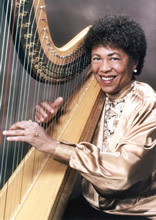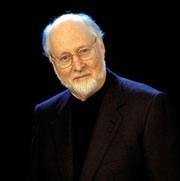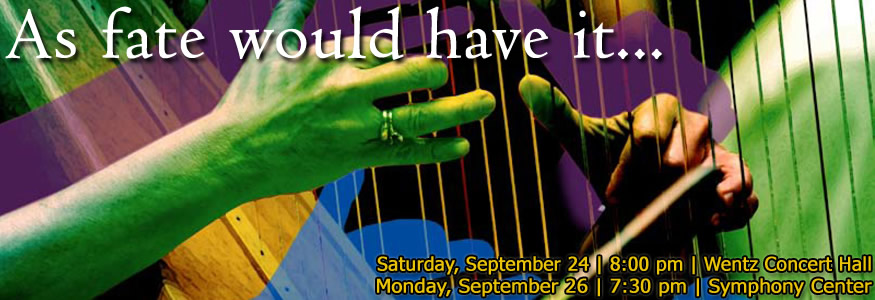[/one_half_last]
THE ARTISTS
[one_half]
Mei-Ann Chen, Music Director and conductor
 As Fate Would Have It is the subscription debut of new Chicago Sinfonietta Music Director Mei-Ann Chen, but it is certainly not her first appearance with the orchestra. When Sinfonietta founder Paul Freeman announced his retirement in 2009, the Sinfonietta embarked on a two-year international search for the first new leader in its 24 year history. Mei-Ann was among eight candidates to be considered, and she conducted the orchestra’s West Meets East concert October of 2009. She wowed us all with her musicianship, enthusiasm, and charisma. Her selection was announced in August 2010, and she was invited back to co-lead Maestro Freeman’s farewell concert this past May. Just this past August, she was formally introduced to Chicago at a spectacular free concert at Millennium Park’s Pritzker Pavilion before a crowd of over 7,000 people.
As Fate Would Have It is the subscription debut of new Chicago Sinfonietta Music Director Mei-Ann Chen, but it is certainly not her first appearance with the orchestra. When Sinfonietta founder Paul Freeman announced his retirement in 2009, the Sinfonietta embarked on a two-year international search for the first new leader in its 24 year history. Mei-Ann was among eight candidates to be considered, and she conducted the orchestra’s West Meets East concert October of 2009. She wowed us all with her musicianship, enthusiasm, and charisma. Her selection was announced in August 2010, and she was invited back to co-lead Maestro Freeman’s farewell concert this past May. Just this past August, she was formally introduced to Chicago at a spectacular free concert at Millennium Park’s Pritzker Pavilion before a crowd of over 7,000 people.
Maestro Chen’s biography can be found here.
[/one_half]
[one_half_last]
In this video she reflects on both her first encounter with the Chicago Sinfonietta and the selections she will lead in As Fate Would Have It.
[/one_half_last]
[one_half]
Ann Hobson Pilot, harp
 The program for As Fate Would Have It includes two selections for harp, but it is a rare thing indeed when one of those pieces was written especially for the harpist who is performing it. Such is the case here. For 40 years, Ann Hobson Pilot was harpist with the Boston Symphony Orchestra, and for 30 of those she was its principal harpist. The career of this pioneering African-American musician was recently chronicled on the PBS special A Harpist’s Legacy: Ann Hobson Pilot and the Sound of Change. Upon Ms. Pilot’s retirement, composer John Williams wrote On Willows and Birches as a gift to her. It received its premieres as openers in 2009 for both the Boston Symphony and Carnegie Hall seasons. The Chicago Sinfonietta performance will be its Chicago premiere.
The program for As Fate Would Have It includes two selections for harp, but it is a rare thing indeed when one of those pieces was written especially for the harpist who is performing it. Such is the case here. For 40 years, Ann Hobson Pilot was harpist with the Boston Symphony Orchestra, and for 30 of those she was its principal harpist. The career of this pioneering African-American musician was recently chronicled on the PBS special A Harpist’s Legacy: Ann Hobson Pilot and the Sound of Change. Upon Ms. Pilot’s retirement, composer John Williams wrote On Willows and Birches as a gift to her. It received its premieres as openers in 2009 for both the Boston Symphony and Carnegie Hall seasons. The Chicago Sinfonietta performance will be its Chicago premiere.
Ann’s website contains a wealth of information about her and her career.
[/one_half]
[one_half_last]
John Williams talks about Ann and the writing of On Willows and Birches in this video. Clip courtesy of WGBH Boston and PBS.
[/one_half_last]
Hear the artists in their own words at Prelude, a pre-concert discussion
one hour before the concert.
THE COMPOSERS
[one_half]
An-Lun Huang
Saibei Dance from Saibei Suite No. 2
 As Fate Would Have It starts out with an encore. Saibei Dance is the first piece that Mei-Ann ever conducted for the Sinfonietta during her guest appearance in October 2009. It was, as she says, love at first sound.
As Fate Would Have It starts out with an encore. Saibei Dance is the first piece that Mei-Ann ever conducted for the Sinfonietta during her guest appearance in October 2009. It was, as she says, love at first sound.
Born to a musical family in China, An-Lun Huang studied piano at the Central Conservatory of Music in Beijing. The Chinese Cultural Revolution of the 1960s forced him to abandon his formal studies, but he continued to study independently, and was appointed resident composer and assistant conductor at the Central Opera House of China in Beijing in 1976. He immigrated to Canada in 1980 to study composition at the University of Toronto before continuing his composition studies at Trinity College in London, England, and eventually at Yale University. His many instrumental and vocal works, including 20 symphonies and eleven operas, possess what has been described as a perfect synthesis of Western and Eastern elements. Saibei is a mountainous area about 80 miles northeast of Beijing, known for its skiing areas and beautiful lakes. Huang has composed numerous works incorporating the folk melodies of that area. Saibei Dance is just such a medley of traditional songs.
[/one_half]
[one_half_last]
This video is of a Beijing performing arts high school orchestra playing the piece.
[/one_half_last]
[one_half]
William Grant Still
Ennanga for Harp, Piano, and Orchestra
 William Grant Still was an African-American classical composer who wrote more than 150 compositions. He was the first African American to conduct a major American symphony orchestra, the first to have a symphony (his first symphony) performed by a leading orchestra, the first to have an opera performed by a major opera company, and the first to have an opera performed on national television. He is often referred to as “the Dean” of African-American composers.
William Grant Still was an African-American classical composer who wrote more than 150 compositions. He was the first African American to conduct a major American symphony orchestra, the first to have a symphony (his first symphony) performed by a leading orchestra, the first to have an opera performed by a major opera company, and the first to have an opera performed on national television. He is often referred to as “the Dean” of African-American composers.
Maestro Freeman championed Still’s compositions throughout his career, but, amazingly, the piece being presented at As Fate Will Have It will be a first for the Sinfonietta. It’s especially fitting, then, that a pioneering African-American harpist will perform its Sinfonietta debut. Ennanga finds the composer, like An-Lun Huang, connecting his musical heritage with the Western orchestra. Titled after the Ugandan harp of the same name, Ennanga evokes its namesake through an ensemble of stringed instruments.
A fairly extensive overview of Still, his compositions, and legacy can be found at AfriClassical, including links to primary sources.
[/one_half]
[one_half_last]
This video of a Ugandan village ensemble features a pair of ennangas along with kalimba and percussion suggests what might have inspired Still to compose Ennanga.
[/one_half_last]
[one_half]
John Williams
On Willows and Birches, Concerto for Harp
 One of the most popular and successful American orchestral composers of the modern age, John Williams is the winner of five Academy Awards, 17 Grammys, three Golden Globes, two Emmys and five BAFTA Awards from the British Academy of Film and Television Arts. Best known for his film scores and ceremonial music, Williams is also a noted composer of concert works and a renowned conductor. He has written many concert pieces, including a symphony, a sinfonietta for wind ensemble, a cello concerto premiered by Yo-Yo Ma and the Boston Symphony Orchestra at Tanglewood in 1994, concertos for the flute and violin recorded by the London Symphony Orchestra, concertos for the clarinet and tuba, and a trumpet concerto, which was premiered by the Cleveland Orchestra in September 1996.
One of the most popular and successful American orchestral composers of the modern age, John Williams is the winner of five Academy Awards, 17 Grammys, three Golden Globes, two Emmys and five BAFTA Awards from the British Academy of Film and Television Arts. Best known for his film scores and ceremonial music, Williams is also a noted composer of concert works and a renowned conductor. He has written many concert pieces, including a symphony, a sinfonietta for wind ensemble, a cello concerto premiered by Yo-Yo Ma and the Boston Symphony Orchestra at Tanglewood in 1994, concertos for the flute and violin recorded by the London Symphony Orchestra, concertos for the clarinet and tuba, and a trumpet concerto, which was premiered by the Cleveland Orchestra in September 1996.
As previously noted, Williams composed On Willows and Birches as a gift to Ann Hobson Pilot. He says this about writing it: “The exciting thing for me about writing concertos is that you are writing for a person – someone. Ann is more than a great harpist, she really is a great woman – it has to do with the inner ear or the inner soul, but she has it all.”
Williams own website contains a wealth of information.
[/one_half]
[one_half_last]
You’ve already seen John Williams reflect on Ann and Willows. Now, for something completely different: John Williams conducts his theme to the NBC Nightly News.
[/one_half_last]
[one_half]
Ludwig van Beethoven
Symphony No. 5, in C minor
 Literally millions of words have been written about Ludwig van Beethoven and his Symphony No. 5. Suffice it to say that the opening of this monumental work consists of what are likely the four most familiar notes in music history. The notion of Fate and the composer’s struggle with it have long been associated with the work, though there is little direct linkage. However, Beethoven himself wrote, in fearful apprehension of his growing loss of hearing, that he would “seize Fate by the throat; it shall not bend or crush me completely.” And indeed, the repeated motive of those four portentous notes throughout the first movement, and their return in the third, feel like a fight against the inevitable. The symphony, however, ends gloriously, suggesting ultimate triumph.
Literally millions of words have been written about Ludwig van Beethoven and his Symphony No. 5. Suffice it to say that the opening of this monumental work consists of what are likely the four most familiar notes in music history. The notion of Fate and the composer’s struggle with it have long been associated with the work, though there is little direct linkage. However, Beethoven himself wrote, in fearful apprehension of his growing loss of hearing, that he would “seize Fate by the throat; it shall not bend or crush me completely.” And indeed, the repeated motive of those four portentous notes throughout the first movement, and their return in the third, feel like a fight against the inevitable. The symphony, however, ends gloriously, suggesting ultimate triumph.
For a somewhat offbeat and certainly obsessive look at the composer, check out the
Mad about Beethoven website.
[/one_half]
[one_half_last]
This video combines various portraits of Beethoven with music from the first movement.
[/one_half_last]
Researched, edited, and compiled by Don Macica
Design by Ryan Smith


